Antiangiogenic Therapy for Metastatic Breast Cancer
Breast cancer is the most commonly diagnosed cancer in women and is the second leading cause of cancer-related mortality, after lung cancer. The overall incidence of breast cancer was increasing until recently, but mortality has declined since 1990, presumably due to earlier detection and better treatments.
Click here to earn Continuing Medical Education Credit
Introduction
Breast cancer is the most commonly diagnosed cancer in women and is the second leading cause of cancer-related mortality, after lung cancer.1 The overall incidence of breast cancer was increasing until recently, but mortality has declined since 1990, presumably due to earlier detection and better treatments.1 Despite great advances in the current therapeutic options for the treatment of breast cancer, many patients will experience relapse and each year more than 40,000 women will die from metastatic breast (MBC).2
There are many approaches to the treatment of MBC, including chemotherapy agents, hormonal therapies, biologics, and supportive care. Significant advances have occurred with the development of novel antiangiogenic treatments that target growth factor receptor signaling pathways. One such pathway involves the vascular endothelial growth factor (VEGF) signal transduction, which is critical in angiogenesis and also important in tumor proliferation. This E-Update will focus on the role of angiogenesis in breast cancer and the impact of antiangiogenic therapy in the treatment of advanced breast cancer.
Angiogenesis in Breast Cancer
Tumor proliferation requires neovascularization, the process of new blood vessel formation, otherwise known as angiogenesis. It has been clearly demonstrated that this process is crucial in tumor growth, survival, and metastasis. The angiogenic switch, a transition from the avascular to vascular phase,3 is regulated by the expression of pro-angiogenic factors, such as VEGF, platelet-derived growth factor (PDGF), basic fibroblast growth factor, and the transforming growth factor β.4 (See Figure 1.)
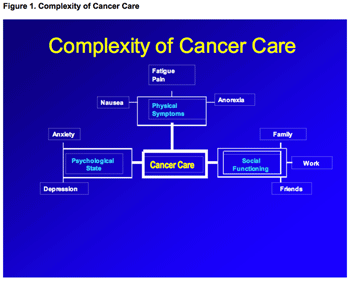
Click to enlarge
One of the most important angiogenic factors is VEGF, which is a potent survival factor for endothelial cells. It binds to a transmembrane immunoglobulin receptor with a tyrosine kinase domain. The family of VEGF receptors (VEGFR) include VEGFR-1 (Flt-1), VEGFR-2 (Flk-1), VEGFR-3 (Flt-4), neuropilin-1, and neuropilin-2.5 VEGFR-2 is the receptor most involved in tumor angiogenesis. VEGF-mediated receptor signaling leads to endothelial cell proliferation and neovascularization and tumor growth. (See Figure 2.)
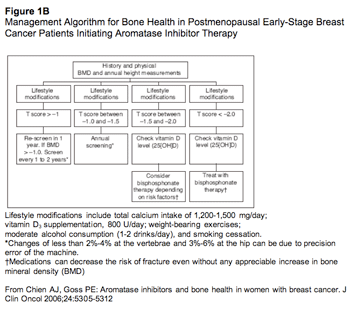
Click to enlarge
Angiogenesis plays a central role in the progression of breast cancer. Examination of noninvasive and invasive breast tumor tissues found increased VEGF expression in tumor cells compared to benign cells, and increased VEGF receptor expression in endothelial cells of small vessels adjacent to malignant tumor cells.6 Increased VEGF expression is also associated with enhanced microvessel density, which is a marker of angiogenic activity.7
Elevated VEGF expression has been associated with decreased relapse-free survival and overall survival in patients with lymph node-negative and node-positive breast cancer.8,9 With this association of elevated VEGF expression and inferior outcomes in breast cancer patients, it appears logical to target VEGF as an antiangiogenic approach in the treatment of breast cancer. This is currently possible through targeting of the ligand (VEGF) or the receptor (VEGF) using monoclonal antibodies or tyrosine kinase inhibitors.
Bevacizumab (Avastin) is a humanized monoclonal antibody that specifically targets VEGF. Treatment with bevacizumab leads to a decrease in tumor microvessel density, normalization of tumor vasculature, a decrease in interstitial fluid pressure, and possibly a more efficient delivery of cytotoxic drugs.10 Large randomized trials have demonstrated the activity of bevacizumab in several tumor types, including, colorectal, lung, renal, and breast cancers.11-15 The US Food and Drug Administration has approved bevacizumab as a first-line and second-line treatment of metastatic colon cancer when used with fluorouracil.
Bevacizumab Monotherapy
In a phase I/II dose-escalation study of bevacizumab in patients with metastatic breast cancer, bevacizumab was given at escalating doses of 3 mg/kg, 10 mg/kg, or 20 mg/kg every 2 weeks.16 The overall response rate for bevacizumab was a modest 9.3%, with a median time to progression (TTP) of 2.4 months and median overall survival (OS) of 10 months.
The toxicity profile of bevacizumab is different than that typically seen with cytotoxic chemotherapies. In this study, four patients discontinued treatment due to adverse toxicities, namely hypertensive encephalopathy, nephrotic syndrome, proteinuria, and headaches. The optimal dose of bevacizumab in breast cancer was determined to be 10 mg/kg every 2 weeks.
Bevacizumab and Chemotherapy
Bevacizumab and Capecitabine vs Capecitabine Alone in Pretreated Patients
Several preclinical studies have demonstrated that anti-VEGF therapy with chemotherapy may be synergistic.17-18 This mechanism of synergy may be due to the normalization of tumor vasculature with anti-VEGF therapy, thus allowing for a more efficient delivery of cytotoxic therapy.10
Two large phase III randomized trials of bevacizumab in combination with chemotherapy have been reported in breast cancer. Miller et al reported the results of a trial of capecitabine (Xeloda) vs capecitabine plus bevacizumab in 462 patients with metastatic breast cancer.13 (See Figure 3.) Eligible patients had anthracycline and taxane-resistant disease and prior chemotherapy for metastatic disease. The dose of capecitabine was 2,500 mg/m2 divided twice daily (14 days on and 7 days off) for both arms and the dose of bevacizumab was 15 mg/kg IV every 3 weeks. The primary endpoint was progression-free survival (PFS).
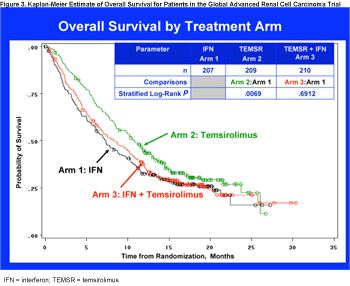
Click to enlarge
In this study, the response rate was superior in the capecitabine plus bevacizumab arm, 19.8% vs 9.1% in the capecitabine alone arm (P = .001). However, the study did not meet the primary endpoint, since the combination therapy did not prolong PFS (4.86 vs 4.17 months, hazard ratio [HR] 0.98, 95% CI 0.77-1.25, P = .857). This was considered a negative trial in this previously treated population.
The addition of bevacizumab did not worsen the severity of capecitabine toxicities. For example, the incidence of grade 3 diarrhea was 10.7% for capecitabine alone vs 11.8% for the combination therapy and the incidence of grade 3 hand-foot syndrome was 24.2% vs 27.5%, respectively. The toxicities worth mentioning with higher incidence rates with bevacizumab were hypertension (grade 3, 17.9% vs 0.5% for capecitabine alone) and proteinuria (grade 1-4, 22.3% vs 7.4% for capecitabine alone). Significant bleeding was rare in both treatment groups. The incidence of thromboembolic events was infrequent and similar between the two groups. Of note, nine patients developed grade 3/4 congestive heart failure (CHF), two (0.9%) in the capecitabine alone group and 7 (3.1%) in the combination arm. Cardiac symptoms improved in all but one patient.
Bevacizumab and Paclitaxel vs Paclitaxel Alone as First-Line Therapy
The next randomized trial was conducted by the Eastern Cooperative Oncology Group (ECOG), which compared weekly paclitaxel against weekly paclitaxel plus bevacizumab as front-line therapy for patients with locally recurrent and metastatic breast cancer.14 The use of weekly paclitaxel in the ECOG 2100 trial was based on preclinical data demonstrating that taxanes may have antiangiogenic activity when given weekly in a low dose.19-20
In this study, 715 patients were randomized to paclitaxel alone at 90 mg/m2 weekly (3 weeks on, 1 week off) and paclitaxel (at the same schedule) plus bevacizumab at 10 mg/kg every 2 weeks. (See Figure 4.) Eligible patients primarily had HER2/neu-negative disease. Those patients who had HER2/neu-positive disease must also have had prior trastuzumab (Herceptin) treatment. Patients could not have brain metastasis, significant proteinuria (> 500 mg/24 hours) or be on anticoagulation medication. Patients may have had adjuvant taxane if 12 or more months had elapsed prior to study entry. Patients were stratified by disease-free interval (< 24 vs 24 months), number of metastatic sites (< 3 vs > 3 sites), adjuvant chemotherapy or not, and hormone receptor status. Two thirds of the patients had prior adjuvant therapy and almost 20% had a taxane previously.
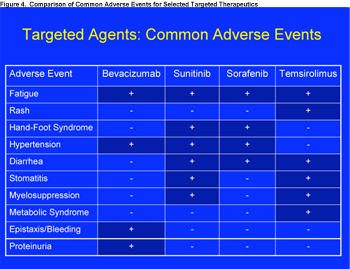
Click to enlarge
The primary endpoint was PFS and the study would be considered positive if there was a 33% improvement in PFS (from 6 months to 8 months). At a second planned interim analysis, there was significant improvement in PFS in favor of the combination arm, 11.4 vs 6.1 months (HR 0.51, P < .0001). There was also a higher response rate seen with the combination, 30% vs 14% (P < .0001). Overall survival is the same in the two arms, 28.4 vs 25.2 months (P = .12) but the data is still immature for OS analysis.
Toxicities were well tolerated. The bevacizumab related grade 3/4 toxicities were hypertension (15.3% vs 2%, P < .0001), proteinuria (2% vs 0%, P = 0.002), bleeding (2% vs 0%, P = .02), fatigue (8% vs 4%, P < .05) , and neuropathy (20.2% vs 14.2%, P = .01).
This supports the use of paclitaxel plus bevacizumab as first-line treatment for breast cancer patients with a similar profile as those in ECOG 2100.
Bevacizumab and Capecitabine as First-Line Therapy
Another trial of first-line bevacizumab with chemotherapy has been recently reported by Sledge et al.21 (See Figure 5.) Known as the XCaliBr trial, it included 106 patients with metastatic breast cancer given capecitabine at a dose of 2,000 mg/m2 divided twice daily (14 days on, 7 days off) and bevacizumab at 15 mg/kg every 3 weeks. Eligible patients had HER2/neu-negative disease and no prior chemotherapy except in the neoadjuvant/adjuvant setting at an interval of more than 6 months.
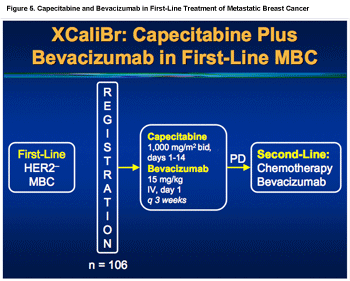
Click to enlarge
The primary endpoint-to detect an improvement in TTP from 4 months to 5.6 months-was met; median TTP was 5.7 months with capecitabine plus bevacizumab. The overall response rate was 38% and median OS was 16+ months.
In a subset analysis, there appear to be better outcomes in the estrogen receptor (ER)-positive group vs the ER-negative group in terms of response rate (47% vs 27%) and median OS (16.6+ vs 7.5 months), but as is true of most subset analyses, this should be viewed with caution and hormone receptor status should not be used to determine if capecitabine with bevacizumab can be used or not.
Although XCaliBr was not a randomized phase III trial of capecitabine alone against capecitabine with bevacizumab, this combination appears to be active as front-line therapy for metastatic breast cancer and can be considered in this patient population.
Bevacizumab Combined With Other Chemotherapeutic Agents
Several phase II trials are also evaluating bevacizumab with other chemotherapeutic agents. Ramaswamy et al reported the results of a study of 27 patients with metastatic breast cancer who were given docetaxel (Taxotere) at 35 mg/m2 weekly (3 weeks on, 1 week off) with bevacizumab at 10 mg/kg every 2 weeks in the first- and second-line settings.22 The overall response rate was 52%; median duration of response was 6.0 months; and median PFS was 7.5 months. There were no unexpected toxicities. Grade 3/4 toxicities were as follows: 15% neutropenia, 4% febrile neutropenia, 15% fatigue, 7% stomatitis, 7% neuropathy, 7% arthralgia, 4% hypertension, and 7% thrombosis.
Burstein and colleagues have reported the result of a phase II trial of vinorelbine (Navelbine) in combination with bevacizumab in patients with up to two prior chemotherapy regimens for metastatic breast cancer.23 In this study, 56 patients received vinorelbine weekly at 25 mg/m2 with bevacizumab at 10 mg/kg every 2 weeks until disease progression. The overall response rate was 31% and 42% in those using this regimen as first-line treatment. The toxicity profile of this combination was also acceptable. Thus, it appears that bevacizumab with chemotherapy is generally well tolerated and has encouraging activity.
Bevacizumab has been evaluated with so-called metronomic chemotherapy using continuous oral, low-dose cyclophosphamide and methotrexate (CM), a regimen believed to have antiangiogenic activity.24 In this study, 55 patients with up to one prior chemotherapy were randomized to CM alone vs CM plus bevacizumab. Overall, the response rates were 10% vs 29% in favor of the combination arm, and 40% of the patients receiving the combination therapy had stable disease.
Additional other ongoing trials are testing the feasibility of bevacizumab with other chemotherapy regimens. Conlin and colleagues are conducting a randomized phase II study evaluating bevacizumab with nanoparticle albumin-bound (nab)-paclitaxel (Abraxane) given every week, dose-dense every 2 weeks, or every 3 weeks in women with advanced breast cancer.25 Traina and colleagues are evaluating bevacizumab with a novel schedule of every other week of capecitabine dosing (personal communication, Tiffany Traina, MD, 2007). Other trials are evaluating bevacizumab in combination with nab-paclitaxel plus gemcitabine (Gemzar)26 and nab-paclitaxel and carboplatin.27 Preliminary data from these studies suggest that these combinations are feasible and we await the efficacy results.
Bevacizumab and Endocrine Therapy
Bevacizumab has been studied with hormonal therapy. Preclinical data suggests that the combination of bevacizumab and endocrine therapy may have advantageous clinical activity. Estrogen is an important modulator of angiogenesis. In vitro data show that endothelial cell proliferation and migration is enhanced by estrogen exposure in human umbilical vein endothelial cell cultures.28 It has been demonstrated that estrogen-induced angiogenesis is mediated via VEGF29 and that estrogen withdrawal reduces VEGF expression in oophorectomized animals.30 Furthermore, estrogen increases VEGF protein levels in MCF-7 breast cancer cell lines31 and aromatase inhibition lowers VEGF expression.32 Jain et al have shown that castration of a mouse with androgen-dependent breast cancer led to vascular regression and tumor reduction. This was followed by endocrine resistance and neovascularization and tumor regrowth.33 Thus, anti-VEGF therapy may delay endocrine therapy resistance.
With this background, Traina et al conducted a feasibility study combining bevacizumab with letrozole (Femara) in postmenopausal patients with hormone receptor-positive metastatic or locally advanced breast cancer.34 In this study, 43 women were given letrozole at 2.5 mg orally daily and bevacizumab at 15 mg/kg every 3 weeks. Since safety was the primary endpoint, prior use of a nonsteroidal aromatase inhibitor was allowed without progression prior to study entry. The grade 3/4 toxicities worth noting are hypertension (16%), headache (5%), proteinuria (5%), and fatigue (2%). Since more than 80% of the patients received a nonsteroidal aromatase inhibitor as first-line therapy for metastatic breast cancer for a median of 18 weeks before study entry, it is difficult to determine the efficacy of this combination. Nevertheless, with an acceptable safety profile from this study, the Cancer and Leukemia Group B is planning a multicenter phase III trial to evaluate first-line endocrine therapy with or without bevacizumab.
Bevacizumab and Targeted Therapies
In addition to combination studies with chemotherapy and endocrine therapy, bevacizumab is also being evaluated with targeted agents. There is data is suggesting an association between the human epidermal growth factor receptor (EGFR)-2 (HER2) and the VEGFR pathways.35 HER2 is overexpressed in 20% to 30% of breast cancer patients and confers a worse outcome.36 In this study, 37 patients positive for HER2, as determined by transcriptional upregulation of VEGF in HER2-overexpressing breast cancer has been reported and it is thought that this may be one of many mechanisms that results in the aggressive nature of HER2-positive breast cancer.
Epstein and colleagues have shown that HER2 overexpression leads to an increased expression of VEGF at the RNA and protein levels.37 Thus, there is evidence supporting studies to evaluate bevacizumab in combination with trastuzumab. A phase I dose-escalation trial of this combination38 led to a phase II study, with early results recently reported by Pegram et al.39 In this study, 37 patients positive for HER2, as determined by fluorescence in-situ hybridization (FISH) amplification, were given trastuzumab weekly and bevacizumab at 10 mg/kg every 2 weeks. Overall, 20 patients (54%) responded. It was reported, however, that there was significant decline in left ventricular ejection fraction, as measured by multigated acquisition (MUGA) scans serially, from baseline to study completion (median of 63% to 60%, P = .02). Thus, this combination should not be used until further safety analysis or confirmation of results.
Another study among the HER2-positive population is a phase II trial now opened to evaluate the activity and feasibility of bevacizumab in combination with lapatinib (Tykerb), a dual tyrosine kinase inhibitor against EGFR and HER2 (personal communication, Maura Dickler, MD, 2007).
Several small molecules target signal transduction pathways that modulate cell growth, apoptosis, and angiogenesis. One such agent is erlotinib (Tarceva), which binds to the EGFR and inhibits its intracellular tyrosine kinase. It is thought that anti-EGFR therapy may be antiangiogenic by decreasing angiogenic proteins from tumor cells and by interrupting the autocrine and paracrine loops that exist between tumor cells and surrounding endothelial cells.40
To test the combination of anti-VEGF and anti-EGFR, one study evaluated the activity of bevacizumab and erlotinib and demonstrated modest activity. The study also found that changes in circulating endothelial cells and tumor cells may correlate with response to therapy.41
Adjuvant and Neoadjuvant Settings
With the benefit of bevacizumab demonstrated in ECOG 2100, a phase II study (ECOG 2104) has been conducted to evaluate the feasibility of bevacizumab in the adjuvant setting. Patients in study arm A receive dose-dense doxorubicin (Adriamycin)/cyclophosphamide (AC) along with bevacizumab followed by paclitaxel with bevacizumab, and then by bevacizumab alone. Patients in arm B also start with dose-dense AC but without bevacizumab, followed (as in arm A) by paclitaxel and bevacizumab, and then by bevacizumab alone, but for more cycles than in arm A. (See Figure 6.) Based on the result of this trial, a subsequent randomized phase III trial (ECOG 50103) will be opening to evaluate contributions of bevacizumab to adjuvant AC (every 2 weeks or every 3 weeks) followed by paclitaxel.
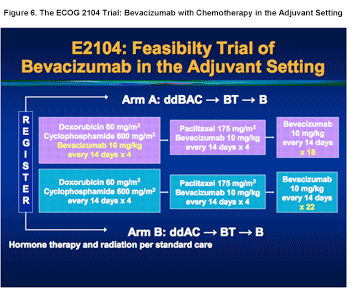
Click to enlarge
Dickler has reported the preliminary results of a feasibility study looking at bevacizumab combined with dose-dense AC for 4 cycles followed by nab-paclitaxel for 4 cycles in the adjuvant setting.42 There is also a trial to evaluate the efficacy of bevacizumab with low dose cyclophosphamide and methotrexate in patients who have residual cancer after neoadjuvant chemotherapy (personal communication, Harold Burstein, MD, 2007).
In the neoadjuvant setting, treatment with docetaxel with or without bevacizumab has been tested in patients with locally advanced breast cancer.43 Patients with tumor responses underwent definitive surgery followed by 4 cycles of AC. Dynamic contrast-enhanced magnetic resonance imaging (DCE-MRI) showed a greater effect on tumor blood flow with bevacizumab added to docetaxel.44
The National Cancer Institute reported the results of a pilot study evaluating a brief course of preoperative bevacizumab followed by 6 cycles of bevacizumab with doxorubicin and docetaxel in patients with locally advanced or inflammatory breast cancer.45 In this study, 14/21 patients (67%) had a partial response. DCE-MRI showed a decrease in vascular permeability on or after the first cycle of bevacizumab.
Next Generation Antiangiogenesis Agents
The next generation of anti-angiogenic agents involves small molecule tyrosine kinase inhibitors of VEGFR, such as sunitinib (Sutent), sorafenib (Nexavar), and others. These agents also interfere with other membrane receptors such as c-kit, PRGFR, Raf, and Flt3, and have proven benefit in renal cell carcinoma and gastrointestinal stromal cell tumors.46-47
Miller et al reported the result of a phase II trial evaluating the effect of sunitinib alone in patients with previously treated metastatic breast cancer.48 In this study, 51 patients were given sunitinb at 50 mg daily (4 weeks on, 2 weeks off). Overall, 7/51 (14%) patients had a partial response. Based on this result, trials are currently being conducted to study sunitinib combined with chemotherapy for MBC treatment.
Sorafenib has shown activity as a single agent in patients with pretreated MBC49 and this is leading to a combination study with chemotherapy.
Rugo and colleagues recently reported the result of a randomized phase II trial studying the effects of docetaxel with or without axitinib (AG-013736), an inhibitor of VEGFR-1, -2, and -3, as first-line therapy for MBC. In this study, 168 patients were randomized in a 2:1 ratio to docetaxel (80 mg/m2 every 3 weeks) with axitinib (5 mg orally twice a day) vs docetaxel and placebo. Overall, the response rates were 40% for docetaxel with axitinib vs 23% for docetaxel with placebo (P = .038). TTP in intention-to-treat patients was also in favor of the axitinib arm, 8.2 months vs 7.0 months (P = .052).50
Other antiangiogenic targeted kinase inhibitors being evaluated include valatinib (pan-VEGF, PDGFR, c-kit), ZD6474 (VEGFR-2, EGFR), ZD2171 (VEGFR-1, VEGFR-2, VEGFR-3), and AMG 706 (VEGFR, PDGFR, c-kit, RET).
Conclusion
The emergence of bevacizumab as the first antiangiogenic agent in the treatment of breast cancer is exciting and promising, but many questions remain. What is the appropriate use of bevacizumab outside of the settings and combinations tested in ECOG 2100 (paclitaxel + bevacizumab) and XCaliBr (capecitabine + bevacizumab)? While there are no randomized data to support the use of bevacizumab as a second-line or further treatment, or to continue it after progression on a bevacizumab-containing regimen, clinical trials are examining these issues.
If hypertension occurs from bevacizumab, does it persist beyond treatment completion? What are standard guidelines to follow for managing proteinuria? Is bevacizumab safe to use in patients with stable, pretreated brain metastasis?
Substantial efforts have been made to identify biomarkers of activity and response to therapy, such as measuring for serum VEGF levels, circulating endothelial cells, circulating tumor cells, and other possible targets. Results, however, have been inconclusive. Thus, at this time, it is difficult to determine which patient population would benefit the most from a bevacizumab-containing regimen.
For now, the following points are worth noting.
- It is appropriate to use bevacizumab and paclitaxel as first-line treatment for MBC.
- It is reasonable to consider bevacizumab and capecitabine as first-line treatment for MBC.
- Although toxicities of bevacizumab are not common, they can be serious (ie, hypertension, proteinuria, bleeding, thrombosis) and patients should be monitored carefully while on treatment.
We await the result of a large randomized trial (ECOG 50103) to identify whether or not bevacizumab will improve outcomes when added to standard AC followed by paclitaxel in the adjuvant setting. There is an urgent need for biomarkers to guide anti-VEGF treatment. We look forward to results of the next generation of antiangiogenic therapies.
CME Post-Test and Evaluation
Continuing Medical Education InformationAntiangiogenic Therapy for Metastatic Breast Cancer
Activity Release Date: August 1, 2007
Activity Expiration Date: August 1, 2008
About the Activity
This activity is based on a brief article developed as part of the E-Update Series and posted on the Web. The series is geared to oncologists and addresses new treatments of cancer or modifications thereof.
This activity has been developed and approved under the direction of Beam Institute.
Activity Learning Objectives
After reading this article, participants should be able to:
a. Explain the role of angiogenesis in tumor growth, maintenance, and metastasis.
b. Identify important angiogenic factors, particularly vascular endothelial growth factor (VEGF).
c. Identify bevacizumab as a humanized monoclonal antibody that specifically targets VEGF and track its emergence as the first antioangiogenic agent in the treatment of breast cancer.
d. List significant findings of key trials using bevacizumab as monotherapy, in combination with chemotherapy, endocrine therapy, and targeted therapies, and apply these findings to clinical practice.
e. Realize that while the toxicities associated with bevacizumab are not common, they can be serious and patients should be monitored carefully while being treated with bevacizumab.
f. Identify next generation antiangiogenic agents and key results of trails indicating activity against metastatic breast cancer.
g. Understand that many questions remain about the use of bevacizumab in the treatment of breast cancer, including concerns about toxicity, the applicability of bevacizumab outside clinical trials, and its use as a second-line therapy.
Target Audience
This activity targets physicians in the fields of oncology and hematology.
Accreditation
This activity has been planned and implemented in accordance with the Essential Areas and policies of the Accreditation Council for Continuing Medical Education through the joint sponsorship of Beam Institute and The Oncology Group. Beam Institute is accredited by the ACCME to provide continuing medical education for physicians
Continuing Education CreditAMA PRA Category 1 Credit™
The Beam Institute designates this educational activity for a maximum of 2 AMA PRA Category 1 Credit(s)™. Physicians should only claim credit commensurate with the extent of their participation in the activity.
Compliance Statement
This activity is an independent educational activity under the direction of Beam Institute. The activity was planned and implemented in accordance with the Essential Areas and policies of the ACCME, the Ethical Opinions/Guidelines of the AMA, the FDA, the OIG, and the PhRMA Code on Interactions with Healthcare Professionals, thus assuring the highest degree of independence, fair balance, scientific rigor, and objectivity.
However, Beam Institute, the Grantor, and CMPMedica shall in no way be liable for the currency of information or for any errors, omissions, or inaccuracies in the activity. Discussions concerning drugs, dosages, and procedures may reflect the clinical experience of the author(s) or may be derived from the professional literature or other sources and may suggest uses that are investigational in nature and not approved labeling or indications. Activity participants are encouraged to refer to primary references or full prescribing information resources. The opinions and recommendations presented herein are those of the author(s) and do not necessarily reflect the views of the provider or producer.
Financial Disclosures
Dr. Dang is a consultant and a member of the speakers' bureau and has received research support from Genentech. Dr. Hudis is a member of the speakers' bureau for AstraZeneca and Genentech; he is also a member of the advisory boards of Amgen, Bristol-Myers Squibb, Novartis, Pfizer, Roche and Sanofi-Aventis. Dr. Hudis has indicated ownership stock in Genomic Health. He has performed research for Kosan Biosciences.
Copyright
Copyrights owned by Beam Institute, a division of CME LLC. Copyright 2007, CME LLC. All rights reserved.
Contact Information
We would like to hear your comments regarding this or other activities provided by Beam Institute. In addition, suggestions for future activities are welcome. Contact us at:
Address:
Director of Continuing Education
Beam Institute
11 West 19th Street, 3rd Floor
New York, NY 10011-4280
Phone: 888-618-5781
Fax: 212-600-3050
e-mail:beaminstitute@cmp.com
Newsletter
Stay up to date on recent advances in the multidisciplinary approach to cancer.